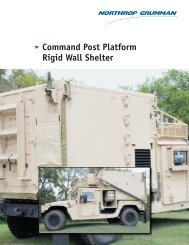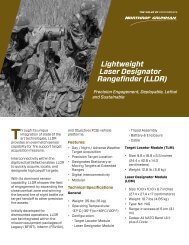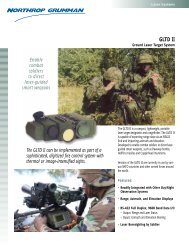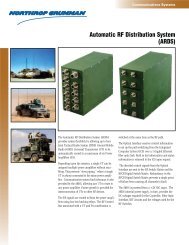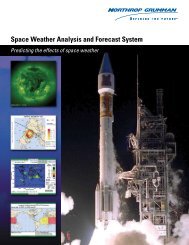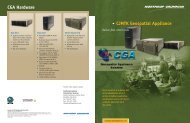Data Sheet - Northrop Grumman Corporation
Data Sheet - Northrop Grumman Corporation
Data Sheet - Northrop Grumman Corporation
You also want an ePaper? Increase the reach of your titles
YUMPU automatically turns print PDFs into web optimized ePapers that Google loves.
Aura<br />
Earth Observing System
Aura Earth Observing System<br />
What’s good? What’s safe? What’s harmful?<br />
Earth’s climate is regulated, in part, by atmospheric<br />
chemicals. The complex interactions of these gases,<br />
both naturally occurring or human-made, may be<br />
contributing to global change. Until we know the longterm<br />
effects of industrial emissions and such natural<br />
phenomena as volcanic eruptions, we can only guess<br />
their impact. We may presume damage where there is<br />
none; we may overlook subtle hazards.<br />
The Aura Earth Observing System satellite helps<br />
clear the air of guesswork. It hosts a suite of<br />
scientific instruments designed to make the most<br />
comprehensive measurements ever undertaken of<br />
trace gases in the environment that surrounds Earth.<br />
The satellite’s orbit allows measurements to be taken<br />
at all latitudes; instruments make continuous scans at<br />
altitudes ranging from the stratosphere down through<br />
the troposphere.<br />
<strong>Data</strong> from the satellite’s instruments focuses on<br />
such timely issues as the effects of increased<br />
industrialization in developing nations, large-scale<br />
biomass burning, ozone depletion and El Nino<br />
conditions. Aura also maps trace gases resulting<br />
from organic decay, lightning and volcanic eruptions,<br />
and studies the chemical dynamics of the atmosphere<br />
over all geographic areas and seasonal climates.<br />
These findings give scientists data needed to identify<br />
and assess the roots of global change.<br />
Aura is based on <strong>Northrop</strong> <strong>Grumman</strong>’s T330 bus,<br />
the same platform hosting NASA’s Aqua mission.<br />
The versatile spacecraft is modular with common<br />
subsystems and easily adapted to the missionspecific<br />
needs of Aura, Aqua and future Earth<br />
observing missions.<br />
Specifications<br />
Size:<br />
Stowed<br />
Deployed<br />
Weight:<br />
Spacecraft<br />
Instruments<br />
Power:<br />
Telemetry:<br />
Orbit:<br />
Launch vehicle: Delta 7920<br />
OMI<br />
Instruments<br />
MLS<br />
TES<br />
8.8 ft h (2.68 m) by 7.6 ft w (2.34 m)<br />
by 22.5 ft l (6.85 m)<br />
15.4 ft h (4.7 m) by 55.9 ft w (17.03 m)<br />
by 22.5 ft l (6.85 m)<br />
6,542 lbs (2,967 kg)<br />
3,896 lbs (1,767 kg)<br />
3,646 lbs (1,200 kg)<br />
4,440 W EOL<br />
S-band<br />
438 mi (705 km) polar,<br />
sun-synchronous<br />
HIRDLS<br />
Microwave Limb<br />
Sounder<br />
MLS THz<br />
Module<br />
MLS GHz Radiometer<br />
MLS<br />
Spectrometer<br />
NASA / Jet Propulsion<br />
Laboratory<br />
TES<br />
HIRDLS<br />
OMI<br />
Tropospheric Emission<br />
Spectrometer<br />
High Resolution<br />
Dynamics Limb<br />
Sounder<br />
Ozone Monitoring<br />
Instrument<br />
NASA / Jet Propulsion<br />
Laboratory<br />
NASA, RAL / University<br />
of Colorado - Boulder,<br />
Oxford University<br />
NIVR, FMI, NASA /<br />
Fokker Space, TNO-TPD,<br />
Finavitec<br />
www.northropgrumman.com/aerospacesystems<br />
© 2013 <strong>Northrop</strong> <strong>Grumman</strong> Systems <strong>Corporation</strong><br />
Printed in USA<br />
Marcom El Segundo<br />
10-0362 • AS • 25 • 4/13 • 47792


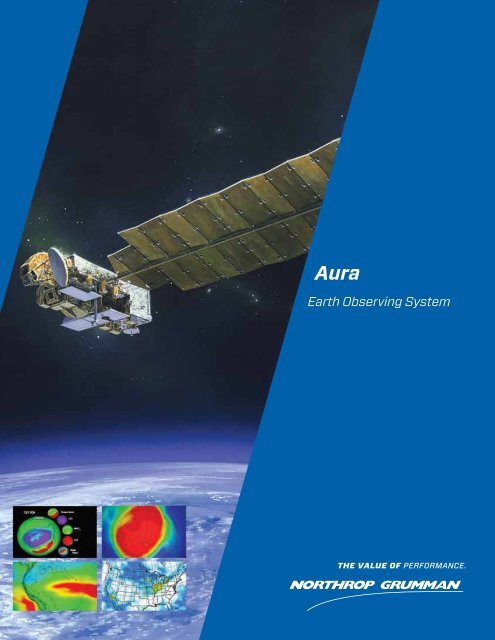
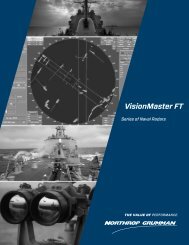
![[x] amendment of solicitation/modification of contract - Northrop ...](https://img.yumpu.com/51622731/1/190x245/x-amendment-of-solicitation-modification-of-contract-northrop-.jpg?quality=85)
